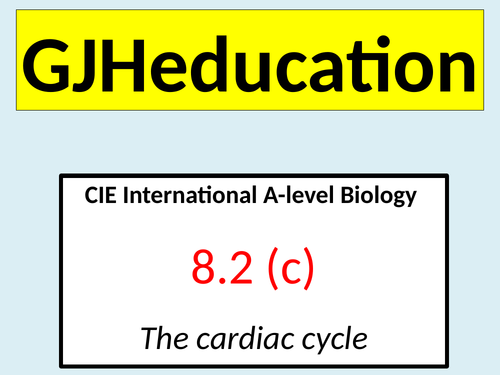


This detailed lesson describes and explains the blood pressure changes that occur during systole and diastole of the cardiac cycle. The PowerPoint and accompanying resource have been designed to cover point 8.2 © of the CIE International A-level Biology specification.
The start of the lesson introduces the cardiac cycle as well as the key term systole, so that students can immediately recognise that the three stages of the cycle are atrial and ventricular systole followed by diastole. Students are challenged on their prior knowledge of the structure of the heart as they have to name and state the function of an atrioventricular and semi-lunar valve from an internal diagram. This leads into the key point that pressure changes in the chambers and the major arteries results in the opening and closing of these sets of valves. Students are given a description of the pressure change that results in the opening of the AV valves and shown where this would be found on the graph detailing the pressure changes of the cardiac cycle. They then have to use this as a guide to write descriptions for the closing of the AV valve and the opening and closing of the semi-lunar valves and to locate these on the graph. By providing the students with this graph, the rest of the lesson can focus on explaining how these changes come about. Students have to use their current and prior knowledge of the chambers and blood vessels to write 4 descriptions that cover the cardiac cycle. The final part of the lesson covers the changes in the volume of the ventricle.
This lesson has been written to tie in with the other uploaded lessons on the heart as detailed in topic 8.2
Get this resource as part of a bundle and save up to 47%
A bundle is a package of resources grouped together to teach a particular topic, or a series of lessons, in one place.
Topics 7 & 8: Transport in plants & mammals (CIE A-level Biology)
This bundle contains 11 fully-resourced lessons which will engage and motivate the students whilst covering the following specification points in topics 7 and 8 of the CIE A-level Biology specification: TOPIC 7 * The structure of xylem vessel elements, phloem sieve tube elements and companion cells * The relationship between the structure and function of xylem vessel elements, phloem sieve tube elements and companion cells * Explain how hydrogen bonding of water molecules is involved with the movement in the xylem by cohesion-tension in transpiration pull and adhesion to cell walls * The pathways and mechanisms by which water and mineral ions are transported from the soil to the xylem and from roots to leaves * Assimilates move between sources and sinks between phloem sieve tubes * The mechanism by which sucrose is loaded into the phloem * The mass flow of phloem sap down a hydrostatic pressure gradient TOPIC 8 * The double, closed circulatory system of a mammal * The relationship between the structure and function of arteries, veins and capillaries * The role of haemoglobin in carrying oxygen and carbon dioxide * The significance of the oxygen dissociation curve of adult haemoglobin at different carbon dioxide concentrations * The external and internal structure of the heart * The cardiac cycle * The role of the SAN, AVN and Purkyne tissue in the initiation and conduction of the heart action The lesson PowerPoints and accompanying resources contain a wide range of tasks which include exam-style questions with mark schemes, discussion points and quiz competitions that will check on current understanding as well as making links to previously covered topics.
Topic 8: Transport in mammals (CIE International A-level Biology)
Each of the 7 lessons in this bundle are fully-resourced and have been designed to cover the content as detailed in topic 8 (Transport in mammals) of the CIE International A-Level Biology specification. The specification points that are covered within these lessons include: * The double, closed circulatory system of a mammal * The relationship between the structure and function of arteries, veins and capillaries * The role of haemoglobin in carrying oxygen and carbon dioxide * The significance of the oxygen dissociation curve at different carbon dioxide concentrations (Bohr effect) * The external and internal structure of the mammalian heart * The cardiac cycle, including the blood pressure changes during systole and diastole * The initiation and control of heart action The lessons have been written to include a wide range of activities and numerous understanding and prior knowledge checks so students can assess their progress against the current topic as well as be challenged to make links to other topics within this topic and earlier topics If you would like to see the quality of the lessons, download the arteries, veins and capillaries lesson as this is free
Topic 8.2: The heart (CIE International A-level Biology)
Each of the 3 lessons in this bundle are fully-resourced and have been designed to cover the content as detailed in topic 8.2 (The heart) of the CIE International A-Level Biology specification. The specification points that are covered within these lessons include: * The external and internal structure of the mammalian heart * The differences in the thickness of the walls of the chambers * The cardiac cycle and the blood pressure changes during systole and diastole * The initiation and control of heart action The lessons have been written to include a wide range of activities and numerous understanding and prior knowledge checks so students can assess their progress against the current topic as well as be challenged to make links to other topics within this topic and earlier topics
Something went wrong, please try again later.
This resource hasn't been reviewed yet
To ensure quality for our reviews, only customers who have purchased this resource can review it
Report this resourceto let us know if it violates our terms and conditions.
Our customer service team will review your report and will be in touch.